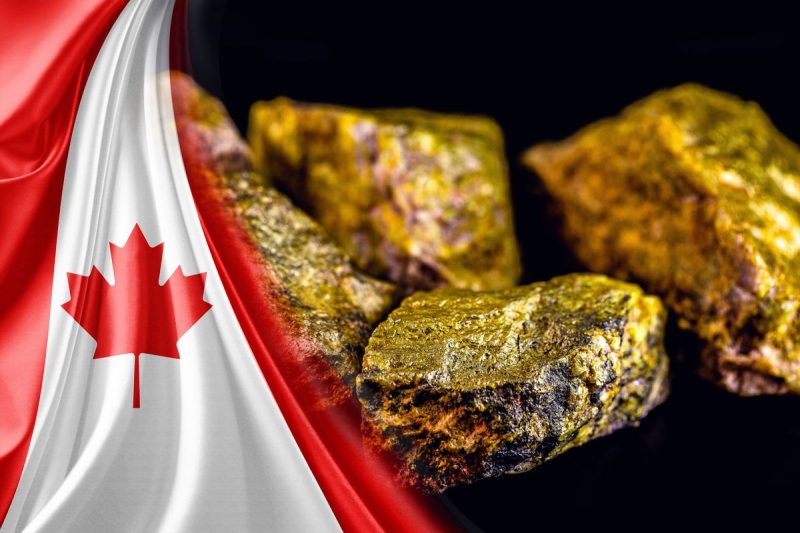
The spot uranium price added 86.41 percent to its value in 2023 and started 2024 at US$90.98 per pound. By late January, prices for the energy commodity had rallied to a 17 year high of US$106.
However, as Q1 progressed, uranium saw some consolidation. By March 11, values had slipped below US$90 for the first time since late December. Even so, prices remain historically high, holding above US$85 as of April 10.
Uranium’s sustained high values following years of underperformance underscore its positive supply and demand dynamics, which are improving as nuclear power becomes an important factor in the energy transition.
‘There’s nothing to keep uranium from going to US$150, US$200 in this environment,’ he said.
Below are the top uranium stocks on the TSX, TSXV and CSE by share price performance so far this year. All data was obtained on April 9, 2024, using TradingView’s stock screener, and all companies had market caps above C$10 million at the time. Read on to learn what factors have been moving their share prices.
1. District Metals (TSXV:DMX)
Year-to-date gain: 140.63 percent; market cap: C$41.8 million; share price: C$0.38
District Metals is an energy metals and polymetallic explorer and developer with a portfolio of nine assets, including five uranium projects in Sweden. It’s currently focused on its Viken property, which hosts a uranium-vanadium deposit.
Historic estimates conducted in 2010 and 2014 peg the indicated resource at 43 million metric tons with an average grade 0.019 percent U3O8, with another 3 billion metric tons with an average grade 0.017 percent U3O8 in the inferred category. According to the company, Viken is one of the “world’s largest in terms of uranium and vanadium mineral resources.’
Shares of District spiked to a Q1 high of C$0.37 on March 11, shortly after the Swedish government announced plans to review a nation-wide ban on uranium mining and exploration that has been in place since 2018.
“We are very pleased with this official statement from the Swedish Government and believe it is a significant step towards lifting the current uranium mining moratorium in Sweden,” Garrett Ainsworth, CEO of District, said. “The Swedish Government has made its intentions clear by stating that ‘the current ban on uranium mining will be removed.’ District is ready for this transformational decision with our portfolio of properties in Sweden.”
Earlier in the quarter, the company completed the acquisition of the remaining four mineral licenses at Viken.
2. Greenridge Exploration (CSE:GXP)
Year-to-date gain: 78.72 percent; market cap: C$13.89 million; share price: C$0.84
Canada-focused Greenridge Exploration is currently engaged in the exploration of the Nut Lake uranium project in the Thelon Basin in Nunavut, Canada. The Nut Lake asset spans 4,036 hectares, and the company says it is strategically positioned near the Angilak uranium deposit, which was recently acquired by Atha Energy (TSXV:SASK,OTCQB:SASKF) through a three way merger with Latitude Uranium and 92 Energy.
Nut Lake is a new property for Greenridge — on January 18, the company entered into an option agreement with three parties to acquire a 100 percent stake in the asset. Historic drilling at the polymetallic deposit has identified “significant” uranium mineralization, with intersections of up to 9 feet containing 0.69 percent of U3O8.
On March 28, the uranium explorer announced the addition of Sean Hillacre to its advisory team. Hillacre, who is the president and vice president of exploration at Standard Uranium (TSXV:STND,OTCQB:STTDF), has more than 10 years of experience as a geologist in Saskatchewan’s Athabasca Basin. Some of that time was spent on the technical team at NexGen Energy (TSX:NXE,NYSE:NXE,ASX:NXG) advancing the Arrow uranium deposit toward production.
Shares of Greenridge trended higher through Q1, reaching a high of C$0.78 for the period on March 31.
3. Myriad Uranium (CSE:M)
Year-to-date gain: 78.38 percent; market cap: C$11.27 million; share price: C$0.33
Exploration company Myriad Uranium holds a significant interest in two promising uranium projects. At Wyoming’s Copper Mountain uranium project, in which it possesses a 75 percent earnable interest, the company is aiming to tap into the “world-class” potential of the district. The state is the US’ top producer of uranium.
Myriad also has an 80 percent stake in uranium exploration licenses comprising 1,800 square kilometers in Niger’s Tim Mersoï Basin, another jurisdiction that boasts world-class uranium deposits.
Shares of Myriad registered a Q1 high early in the period, hitting C$0.39 on January 21. The share price bump coincided with news that the company was welcoming “renowned geologist and the pre-eminent authority on Copper Mountain and its uranium endowment” Jim Davis, to its technical committee.
Commenting on the appointment, Myriad CEO Thomas Lamb said, “On October 31, 2023, we announced historic resource estimates and resource targets relating to Copper Mountain. These estimates and targets were the product of C$100 million in exploration and development spends by Union Pacific during the 1970s. Much of this work was led by Jim Davis, and we are delighted he is joining our Technical Committee.”
4. CanAlaska Uranium (TSXV:CVV)
Year-to-date gain: 71.43 percent; market cap: C$98.61 million; share price: C$0.66
CanAlaska Uranium is a self-described project generator with a portfolio of assets in the Athabasca Basin. The region is well known in the sector for its high-grade deposits, which helped birth the moniker ‘the Saudi Arabia of Uranium.’
The company’s five asset portfolio includes the West McArthur property, which is situated near sector major Cameco (TSX:CCO,NYSE:CCJ) and Orano Canada’s McArthur River mine. In 2018, Cameco signed on as a joint venture partner for CanAlaska’s project and the company retains a 16.65 percent stake.
The uranium explorer made several announcements over the 90 day period, including the approval of a C$7.5 million exploration program at West McArthur. On February 28, the company reported high-grade intersections at the Pike zone at West McArthur. The discovery was made during the exploration firm’s winter drill campaign.
The statement drill hole, WMA082-4, intersected 13.75 percent U3O8 equivalent (eU3O8) over 16.8 meters, including 40.3 percent eU3O8 over 4.7 meters and 13.54 percent eU3O8 over 2 meters. CanAlaska’s share price jumped from C$0.46 on February 27 to C$0.74 the day of the news, and marked a Q1 high of C$0.75 on March 7.
5. Premier American Uranium (TSXV:PUR)
Year-to-date gain: 69.68 percent; market cap: C$41.45 million; share price: C$2.63
Premier American Uranium is focused on consolidating, exploring and developing uranium projects in the US. The company, which was spun out of Consolidated Uranium in late 2023, currently has four assets in two major uranium-producing jurisdictions: Wyoming’s Great Divide Basin and Colorado’s Uravan Mineral Belt.
On March 20, Premier announced plans to acquire American Future Fuel (OTCQB:AFFCF), which would give Premier access to the Cebolleta uranium project located within the Grants Mineral Belt of New Mexico.
The all-share deal will see the combined value of the merged companies sit at C$129 million.
“The announcement … marks a significant leap in our journey to strengthen our foothold in the US uranium market through opportunistic and strategic M&A,” said Tim Rotolo, chairman of Premier American Uranium. “By acquiring a key project, we’re not just enriching our portfolio; we’re also setting our roots in three principal uranium regions, paving the way for rapid growth.” Shares of Premier reached a quarterly high of C$3.09 on February 8.
FAQs for investing in uranium
What is uranium used for?
Uranium is primarily used for the production of nuclear energy, a form of clean energy created in nuclear power plants. In fact, 99 percent of uranium is used for this purpose. As of 2022, there were 439 active nuclear reactors, as per the International Atomic Energy Agency. Last year, 8 percent of US power came from nuclear energy.
The commodity is also used in the defense industry as a component of nuclear weaponry, among other uses. However, there are safeguards in effect to keep this to a minimum. To create weapons-grade uranium, the material has to be enriched significantly — above 90 percent — to the point that to achieve just 5.6 kilograms of weapons-grade uranium, it would require 1 metric ton of uranium pre-enrichment.
Because of this necessity, uranium enrichment facilities are closely monitored under international agreements. Uranium used for nuclear power production only needs to be enriched to 5 percent; nuclear enrichment facilities need special licenses to enrich above that point for uses such as research at 20 percent enrichment.
The metal is also used in the medical field for applications such as transmission electron microscopy. Before uranium was discovered to be radioactive, it was used to impart a yellow color to ceramic glazes and glass.
Where is uranium found?
The country with the greatest uranium reserves by far is Australia — the island nation holds 28 percent of the world’s uranium reserves. Rounding out the top three are Kazakhstan with 15 percent and Canada with 9 percent.
Although Australia has the highest reserves, it holds uranium as a low priority and is only fourth overall for production. All its uranium output is exported, with none used for domestic nuclear energy production.
Kazakhstan is the world’s largest producer of the metal, with production of 21,227 metric tons in 2022. The country’s national uranium company, Kazatomprom, is the world’s largest producer.
Canada’s uranium reserves are found primarily in its Athabasca Basin, and the region is a top producer of the metal as well, although some of the major mines have been under care and maintenance in recent years.
Why should I buy uranium stocks?
Investors should always do their own due diligence when looking at any commodity so that they can decide whether it fits into their investment plans. With that being said, many experts are convinced that uranium has entered into a significant bull market, meaning that uranium stocks could be a good buy.
A slew of factors have led to this bull market. While the uranium industry spent the last decade or so in a downturn following the 2011 Fukushima nuclear disaster, discourse has been building around the metal’s use as a source of clean energy, which is important for countries looking to reach climate goals. Nations are now prioritizing a mix of clean energies such as solar and wind energy alongside nuclear. Significantly, in August 2022, Japan announced it is looking into restarting its idled nuclear power plants and commissioning new ones.
Uranium prices are very important to uranium miners, as in recent years levels have not been high enough for production to be economic. However, in 2024, prices spiked from the US$58 in August 2023 to a high of US$106 per pound U3O8 in February 2024. At this price level, uranium stocks remain highly undervalued.
Securities Disclosure: I, Georgia Williams, hold no direct investment interest in any company mentioned in this article.

